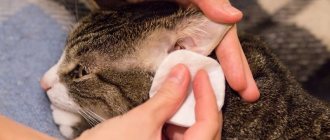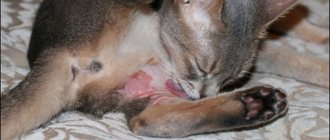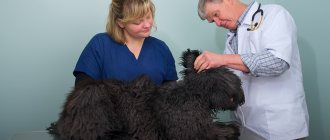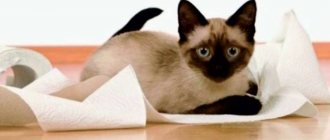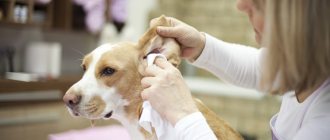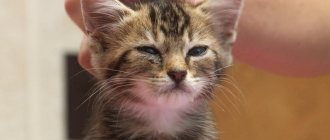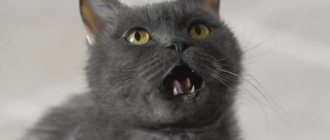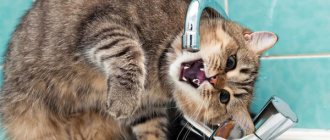Why does a cat scratch its ears?
It is normal for pets to scratch their ears. So they independently clean them of foreign particles and dirt. An animal can perform this necessary hygienic procedure several times a day; there is nothing unnatural about this. But there are some signs that should alert the owner:
- The cat scratches its ears continuously and at the same time strongly shakes its head in one direction or the other, as if trying to free itself from some object.
- The cat becomes restless, irritable, and sometimes aggressive.
- When scratching its ears, the animal can make various sounds, hiss, purr, and meow.
- Scratches, wounds, and sores appear behind the ears and in the shells, causing painful discomfort to the cat.
Why do my cat's ears itch? The causes of this phenomenon are usually divided into two groups - everyday and pathological.
Household infections can be diagnosed by owners, go away on their own after some time and do not require drug treatment. These include:
- Getting water into your ears after swimming.
- Foreign body.
- Minor hematoma resulting from trauma.
- A large amount of sulfur accumulated in shells due to insufficient care, which the cat is not able to remove without outside help.
It may well be that the cat simply rested his ear and is scratching it because of this, so before you run to the veterinary clinic, you should observe the pet’s behavior.
Pathological causes pose a serious danger to the health of the cat, these include:
- otitis;
- fleas;
- allergy;
- neoplasms in the ears, including malignant ones;
- fungal infections;
- dermatitis;
- ear mites (otodectosis);
- abscess.
These diseases require immediate treatment; the veterinarian will tell you what to do in such cases.
When communicating with the owner or expressing emotions, the cat flattens its ears. This is just a small but very significant part of body language. If you doubt that your pet flattens its ears without good reason, you should carefully observe its behavior. The fact is that a cat's ears are very sensitive, their position and movements can indicate a lot of phenomena.
Dog lovers are not surprised when their dogs flatten their ears and wag their tails, because this expresses joy. In a similar situation, when a cat pins its ears to its head and wags its tail, it is better to leave it alone, since this behavior shows clear displeasure or irritation
. Irritation or even aggression is expressed by raised fur, sharp movements of the tail, a determined expression on the face and hissing, which indicates that the cat is ready to attack.
When showing tenderness, cats usually do not press their ears back, but there are other options:
- The pet presses its ears in response to stroking.
- The cat flattens its ears when it rubs its head.
In other situations, the ears are always turned forward, as if catching the actions of the owner.
Hunting
- a process in which quadrupeds actively use hearing to track prey, but once the target is detected, the cat's tactics change. The pet clings to the ground, moves as slowly and silently as possible, even the movements of the eyelids become smoother. Then, the cat flattens its ears to make its silhouette smoother and less noticeable. Movements are made only on half-bent legs and when the victim turns away.
Fear or severe discomfort
also accompanied by a posture with ears flattened. Visually, the animal looks insecure and meek. As soon as the danger has passed, the pet raises its ears and retreats away from the irritant or threat.
When sleeping, cats often curl up into a ball, pressing their ears. This pose has a number of advantages:
- Heat retention.
- Limb protection.
- Willingness to stand up or jump at any moment (one paw is always slightly turned toward the floor).
- Neck and head protection.
Method of communication
Cats, in addition to meowing, communicate with their owners using sign language. For this they use
:
By behavior you can understand what the animal wants to say. If the ears are pressed tightly to the head and turned back, the hair on the body is raised - it means that the cat is tense or scared, as it feels threatened. You need to behave kindly with your pet and calm him down.
When a cat twitches its tail and presses its ears to its head, it wants to express its dissatisfaction or irritation. It’s worth figuring out what’s wrong, eliminating the cause, and then the animal will stop behaving this way.
The cat lies on the ground, then presses its ears, then pricks them up, this means that it is very keen and is hunting. At this moment, it is better not to touch the animal or disturb it.
The cat also flattens its ears when its head is stroked or when it rubs itself. A strong, loud noise will also cause a cat to flatten its ears. In all other cases, they stick out and pick up the slightest sounds.
A cause for concern should be if your cat is constantly pressing one ear. At the same time, she shakes her head and often scratches her ear. Possible reasons for this
:
Any of these reasons will cause discomfort to the animal. Both the left and right ears can suffer. If you notice that the ear is often pressed to the head, you need to examine the cat's ears. This will allow us to identify what caused these symptoms.
Ear dirt can be easily removed by yourself
It is only recommended to do this very carefully, since sloppy and rough movements lead to injuries to the auditory canal. If a foreign body is detected, you can remove it yourself
If the attempt is unsuccessful, it is better to contact a veterinarian for qualified assistance.
Otitis media usually causes swelling and tenderness of the ear canal, and discharge is present. Here you cannot do without the use of antibacterial drops, ointments, and antihistamines. In this case, consultation with a doctor is mandatory; only he will be able to establish the correct diagnosis and prescribe competent treatment. The sooner treatment is started, the faster the recovery without complications.
Severe itching of the ear causes mite infestation. The mite can be ear or subcutaneous. The first species lives directly in the ear canal. Its presence, in addition to itching, is accompanied by discharge from the ear and the appearance of plaque. The subcutaneous mite most often settles above the eyes and near the ears in the superficial layers of the skin. Over time, it spreads, almost the entire body and ears become infected.
Constant observation and care of your beloved pet will help him always remain healthy and cheerful, and the owner calm!
I believe that the Scottish Fold cat is one of the smartest and most obedient creatures. This breed is in good health and there are practically no problems with them. The physique is strong, even the muscles are visible)) The coat is thick and very soft.
My favorite name is Monica. Despite her young age (half a year old), the girl is very smart. There were no problems with toilet training, although I had to pick her up from her parents' house very early.
She eats exclusively natural food (lean meat, fish, raw eggs), drinks only homemade milk, loves kefir and cottage cheese. I heard that the Scots should not be constantly given food rich in protein and calcium. Therefore, I tried to give her a balanced food designed specifically for this breed. Monica did not like this artificial food.
My favorite feature of this breed is the ability to stand on its hind legs for a long time, like a meerkat. Monica loves to sit on the windowsill in this position and watch the birds. Loves to play and watch TV. Sleeps on his back.
Scots are easy to train. Monica quickly got used to the scratching post, but in the future I plan to remove her claws (when she plays, she might run over me and accidentally scratch me).
Only for some reason my girl’s ears have risen a little for winter. I don’t know what this is connected with, maybe with protein foods. But this doesn't bother me at all.
Cat ear diseases
As mentioned above, if a cat starts shaking its head, it most likely has an earache. In this case, head shaking is provoked by the desire to stop the discomfort. Note that sudden movements partially help dull the pain.
In veterinary medicine, there are more than a dozen diseases that can cause ear pain, itching, blurred vision, dizziness... and all these symptoms will cause the cat to shake its head. Even toothache can lead to similar behavior.
Let's look at the symptoms of the most common diseases. A relatively rare phenomenon in cats is weather dependence. Simply put, a cat gets a headache when its blood pressure changes. You will not be able to officially confirm this diagnosis, but it can be easily identified by observing the animal’s behavior. Quite often, weather dependence becomes a mystery, since the cat experiences discomfort at different times of the day. seasons of the year, etc., and the owner cannot connect these signs into one logical chain.
Insufficient hygiene
Cats that live indoors are not as susceptible to ear diseases as those that roam the streets. But you need to take care of your hearing hygiene in any case. Therefore, if your cat is shaking his head and scratching his ears, then take him to the vet. If there is an unpleasant odor and an accumulation of brown discharge, then most likely the animal has otodecosis, which we will discuss later. This is a fairly serious disease, so you need to choose the right therapy. In addition to regularly cleaning your cat’s ears to remove plaque, systematic prevention should be carried out. Since such a serious disease can be transmitted to other animals. It is also necessary to periodically examine your pet's ears. Since poor hygiene and advanced disease can lead to more serious consequences.
Allergy
Why does a cat scratch his ear, but it is clean? It is possible that the animal is allergic to some product. In order to determine exactly what food the reaction is occurring to, various tests are performed. They also give antihistamines and local (drops and other) medications.
Now it’s clear, he’s scratching his ears and head. As you can see, there are many reasons for this animal behavior. Therefore, be sure to clean your pet’s ears on time; we have described how to do this. Proper hygiene of an animal's ears is an excellent prevention of disease.
Many people ask how to determine whether a newborn kitten is lop-eared. In a newborn it is not visible at all. Look at the photo above: do you even see anything in it? But from the 18th day it is already clear what kind of ears the kitten will have - straight or curved. Then you will see that some kittens’ ears have fallen a little forward and down.
When kittens develop lop ears, it is already clear that their ears droop with one, two or three folds or do not have them at all. There is an opinion among breeders that if there is only one fold, then, most likely, with age the ears will rise completely or rise. If there are two folds, then depending on your luck: they can rise only a little, or they can rise a lot and become so-called helicopters. However, other breeders will object: sometimes the quality of ear fit does not depend on the number of folds.
So, the signs of lop ears in a kitten are as follows: curved down and forward + folds + smaller size of the ear. There are no other signs, such as the color of the fur on the ears, etc. degrees
My cat's ears itch - is this normal?
It is normal for a living creature to scratch its ears. This way the pet cleans them of dirt and foreign particles. He can do this up to several times a day and it will be within normal limits. When does ear scratching cease to be a daily hygiene procedure? It is worth noting that:
- The animal is worried when scratching, the cat shakes its head irritably and actively.
- The pet became nervous and irritable.
- When brushing, the cat purrs or hisses.
- Scratching became more frequent up to 10 times a day.
- Bleeding wounds appeared in or behind the ears.
If several of the listed signs coincide, you should think about visiting a veterinarian.
Choosing the right kitten
The most characteristic feature of the American Curl is the curl on the ears. This is exactly why you need to choose a kitten. The best time for this is when the curl is visible clearly and clearly - and this is 4 months from birth. It is after this time that the wrapping of the ears ends.
It will be immediately noticeable whether he will be a breeding cat, whether your pet is applying for an exhibition or will be a domestic cat:• a domestic cat will have the smallest angle of wrapping (the first degree);• a larger angle or another degree will show you a breeding cat, it is better to keep this one for breeding;• steep a curl or third degree is a manifestation of an exhibition handsome man.
The price of the kitten will depend on this. Ideally, a kitten's ear curl should be in the form of a neat curve, similar to a crescent. It is worth noting that in advance, before the end of the 4-month period, it is almost impossible to determine to what degree the ear will twist. You don’t even have to take the kitten’s relatives; two show kittens can give birth to both a show kitten and a domestic one.
READ Diarrhea after vaccination. Diarrhea in a puppy after vaccination: reasons, what to do
In addition to appearance, you need to pay attention to the pedigree of the little Curl. The price will also depend on who its parents were:• if the kitten does not have a pedigree, then its price will be in the range of 3-10 thousand rubles;• pedigree Curls are valued more - from 10 to 20 thousand;• purebred show kittens will cost to the buyer 25,000 or more.
When purchasing, you should read in detail all the documents for the kitten, and especially look at its behavior. They should be calm and not at all shy.
Movements of the tail
Tail movements
– the main indicator of changes
in a cat’s mood
.
Light wagging of the tip of the tail indicates that the cat is curious
or irritated by something.
Sometimes this tail movement indicates that the animal is depressed. Sharp swings of the tail up and down express strong excitement
, noticeable rotations of the tip of the tail are a sign of
strong anxiety
, which can bring the animal into a state of readiness to repel an attack, into a defensive position.
When the cat
If she doesn't like something, she doesn't hide it.
Her behavior and the movement of her tail
indicate this.
At the stage of highest irritation, the cat also gives sound signals. After such preventive measures, she proceeds to active actions, defends herself, attacks. When defending a cat
sits on its hind legs and uses its claws and teeth. If she is in danger, she tries to hide, to run away.
Cats
very smart, playful, agile, extremely resilient and willful.
They have the ability to feel the mood of the owner and are devoted to him. If the cat
realizes that swinging on the doorknob can open the door, it will achieve its goal.
There is a known cat who, in order to quench her thirst, banged her paw on the water tap until water began to drip from the tap. She devoted all her free time to such an activity, even when water was poured into her dishes. The cat
gets used to its home, especially if it enjoys freedom. Therefore, it is extremely difficult for her to come to terms with moving to a new apartment. At the first opportunity, she strives to return to her usual place.
Unique characteristics of the breed
Owners of Scottish Folds share their observations. For example, some Scottish women love to dream with their paws stretched out in front of them.
Surprisingly, these cats are unique in that they can easily sleep on their backs. Standing at attention on its hind legs, when the cat begins to resemble a gopher, is characteristic only of the Scottish Fold.
Owners also testify that their pets love massage done with a comb. It is noteworthy that they are not averse to being combed either lengthwise or against their fur.
Basically, owners of Scottish Folds are unanimous in their opinion that cats of this breed are excellent pets. They are gentle, intelligent, and easy to train. Well, their unique exterior invariably touches everyone.
Scottish Folds have the only serious drawback - hereditary diseases. If chondroosteodystrophy or hemophilia is detected, specialists prescribe a course of relief from symptoms. Those animals that are lucky enough to avoid genetic diseases enjoy good health.
This is interesting - the most popular cat breeds with pictures.
Popular kennels for this breed:
- Russia - (your nursery is here);
- Belarus - (take place);
- Ukraine - (submit an application).
Movements of the tail
Tail movements
– the main indicator of changes
in a cat’s mood
.
Light wagging of the tip of the tail indicates that the cat is curious
or irritated by something.
Sometimes this tail movement indicates that the animal is depressed. Sharp swings of the tail up and down express strong excitement
, noticeable rotations of the tip of the tail are a sign of
strong anxiety
, which can bring the animal into a state of readiness to repel an attack, into a defensive position.
When the cat
If she doesn't like something, she doesn't hide it.
Her behavior and the movement of her tail
indicate this.
At the stage of highest irritation, the cat also gives sound signals. After such preventive measures, she proceeds to active actions, defends herself, attacks. When defending a cat
sits on its hind legs and uses its claws and teeth. If she is in danger, she tries to hide, to run away.
Cats
very smart, playful, agile, extremely resilient and willful.
They have the ability to feel the mood of the owner and are devoted to him. If the cat
realizes that swinging on the doorknob can open the door, it will achieve its goal.
There is a known cat who, in order to quench her thirst, banged her paw on the water tap until water began to drip from the tap. She devoted all her free time to such an activity, even when water was poured into her dishes. The cat
gets used to its home, especially if it enjoys freedom. Therefore, it is extremely difficult for her to come to terms with moving to a new apartment. At the first opportunity, she strives to return to her usual place.
Pathologies and diseases
Pathological causes of ears pressing to the head:
- Itching of the skin. In this case, pressing the ears is a reaction to ear or subcutaneous mites or fleas. If there is a subcutaneous tick, your pet's ears will often be pinned back. The itching will spread to the face, neck, and entire body.
- Jumps in blood or atmospheric pressure. They usually manifest themselves as a sudden headache.
- Neurological disorders that can cause auditory hallucinations in an animal.
- Painful sensations. Various diseases can provoke attacks of pain. As a rule, the cat also has other accompanying symptoms: it refuses food, stops being active, preferring to lie down most of the time, and changes its behavior.
- why does the cat have cold ears?
- why does the cat hide under the blanket;
- what a healthy nose should be like for a cat.
Inner ear
In cats, the inner ear (labyrinth) is the deepest part of the entire auditory system. It includes the sensory structures of the apparatus and balance. The ear canal is protected here by the temporal bone. In this ear of cats there is a very important organ of Corti, which converts sounds coming from the eardrum into electrical impulses that are transmitted through neural networks to the brain.
In addition, the vestibular apparatus is located in this area - three semicircular small fluid-filled canals. They contain microscopic hairs. All fluid movements are captured by these bristles, which generate nerve impulses. The brain receives these signals and determines the horizon line, the position of the body, where is up and down and the animal maintains balance.
Thus, in cats, the ears consist of a sound-receiving system and organs that help animals maintain balance during movements.
Owners of such delicate pets should know the structural features of cats' ears in order to properly care for these important organs.
My cat's ears itch - is this normal?
It is normal for a living creature to scratch its ears. This way the pet cleans them of dirt and foreign particles. He can do this up to several times a day and it will be within normal limits. When does ear scratching cease to be a daily hygiene procedure? It is worth noting that:
- The animal is worried when scratching, the cat shakes its head irritably and actively.
- The pet became nervous and irritable.
- When brushing, the cat purrs or hisses.
- Scratching became more frequent up to 10 times a day.
- Bleeding wounds appeared in or behind the ears.
If several of the listed signs coincide, you should think about visiting a veterinarian.
Therapy methods
Treatment depends on what problem is causing the itching. This could be dermatitis, fungus, ear mites, otitis media and other pathologies.
Dermatitis should be treated with drops containing novocaine. Using a swab dipped in hydrogen peroxide, the crusts are carefully removed, and the ulcers are treated with an astringent ointment.
Fungal infections are treated with antifungal agents.
Ear mites are removed by mechanical cleaning of the ear canals. A swab soaked in hydrogen peroxide is used. Additionally, medicinal drops and ointments are used. In case of advanced disease, injections with antibiotics are prescribed.
Therapy for otitis media is selected depending on the disease. First of all, you need to treat the ears with a cotton swab with peroxide.
Immediately after these manipulations, treatment procedures using the following drugs begin:
- Leopard;
- Otoferonol premium gold;
- Aurikan;
- Oricin;
- Surolan;
- Ordermil.
Tick-borne otitis media is treated comprehensively. Drugs prescribed:
- Anandin;
- Tsipam;
- Decor.
Antimycotic agents are also used:
- Clotrimazole ointment;
- shampoos Nizoral, Sebazol.
The products are applied to the inside of the ear. They cannot be washed off, otherwise there will be no therapeutic effect.
For fungal and yeast forms of otitis, it is necessary to strengthen the animal’s immunity.
The bacterial variety of pathology often leads to the development of diseases that are difficult to treat.
Local medications are prescribed:
- Otonazole;
- Otibiovin;
- Mastitis.
Advanced forms of the disease are treated with novocaine blockades with antibiotics. After the course of treatment, preventive treatment is carried out. This helps prevent relapses.
Special drops are used against fleas; they are applied to the withers. If the animal is often outdoors, then an anti-flea collar is used.
Detected hematomas, formations, and polyps are removed surgically. Identified foreign bodies are removed immediately. The animal's ears are treated with antiseptic drugs.
Features of treatment
The therapeutic course is selected by the veterinarian and depends on the diagnostic results. For otitis media, antibacterial treatment is prescribed. If the pain syndrome is severe, a novocaine blockade is done, and special drops for otitis media are instilled into the ear.
You can get rid of ticks using external means such as Tactic, Amit. Intramuscular injections of antiparasitic drugs are effective. The ears are first cleaned of exudate with a cotton swab dipped in hydrogen peroxide. For dermatitis, the auricle is treated with a solution of silver nitrate.
During treatment, you must be observed by a doctor, visiting the clinic at least once a week.
How to properly put drops in a cat's ears?
If your cat scratches its ears, then your doctor may prescribe special drops as primary or additional therapy. However, not all animals are able to calmly endure this unpleasant procedure. There are several rules that should be strictly adhered to.
- Under no circumstances should the drops be cold. The optimal solution is to take them out of the refrigerator half an hour before instillation of the ears to warm them up a little. In extreme situations, you can warm the bottle in warm water.
- Most likely, the cat will scratch, twitch and try to escape. Therefore, it is better to wrap it in a thick towel or blanket first. The pet's head must be held lightly.
- Two people will do this task better, so ask someone at home to help you in advance. For example, while one is holding a cat wrapped in a blanket, the other is moving the edge of the ear and dripping medicine into it.
To avoid complications, take at least a few minutes a week to examine your animal. Quick diagnosis of problems and treatment of a cat is the key to good health and excellent well-being for your pet.
Previous Question and AnswerWhy does a cat drink tap water? Next Question and Answer Cats have black ears - symptoms and treatment
Diagnosis of ear diseases in cats
At the first sign of itching in the cat’s ear area, you should watch it, and, if possible, sit the pet on your lap and turn out the ear. Consider whether there is redness, dark plaque, foreign objects or inflammatory nodules.
Palpate the parotid area for swelling and tenderness. If you identify suspicious processes, you should immediately seek help from a specialist.
In a clinical setting, ear problems in cats are determined in the following ways:
- During an examination by a veterinarian, the ear canal is examined with an otoscope (the device allows you to see neoplasms, hematomas, foreign bodies, genetic abnormalities, and inflammatory processes).
- Scraping of ear secretions for microscopy and determination of the nature of the pathology (fungus, ear mites are determined).
- Biopsy of tumors in a cat’s ear to determine malignancy.
An experienced doctor can often visually determine the cause of the disease and prescribe treatment for the cat without laboratory tests.
Folk signs when determining gender
Distinguish between a cat and a female cat according to folk signs. They are not so reliable, but they are supported by the experience of generations.
These include:
- Sight. It is believed that boys have a stern or arrogant look, while cats are modest and meek. The method is questionable, since there are no fewer arrogant girls than boys.
- The amount of fur in the genital area. Males have more of it. This is true, but if you plan to sell the kitten, it is better to use proven and reliable methods.
- Behavior. It is enough to monitor how the kitten behaves. Boys are playful, cocky, and often fight and bite. The girls are calm and shy.
- Tail position. If you place a saucer of milk on the floor, it is believed that the boy will run towards it with his tail in the air. Girls run around with their tails down.
There are many options for determining the gender of a young cat.
However, if the owner does not have the opportunity to wait until the reproductive system is fully formed or there are difficulties in determining it, it is worth contacting a veterinary clinic, a familiar breeder or an experienced cat owner.
Eye movement. Glances and gestures
Cat
, sitting near the door with her head raised, makes it clear that she wants to enter. But if she sits near the door with her eyes downcast, her posture means that there is someone behind the door. Some cats
, trying to leave the house, they jump on door handles and, after a little practice, open them, and sometimes not only ordinary ones, operating on the principle of a lever, but also round ones.
According to stories, cats
can be taught to use a door knocker.
After knocking on the door, they sit down and patiently wait for it to be opened. Some cats
rush at people who enter the house without knocking or in an unusual way, that is, they behave like watchdogs.
If you had to punish cat
, the animal can express its displeasure by turning its back to you and starting to brush its fur. This gesture
designed to make you fuss over her until she finally condescends to answer. Then your pet will be naughty a little more, happy that the troubles are over and forgiveness has been received.
Cat behavior
largely depends on her upbringing, which should begin from an early age. If you make a kitten
If you make some concessions, then you should be prepared to make the same concessions for an adult
cat
, since it
is almost impossible to wean her from what she was used to in childhood.
" article "
The language of cats and cats: a cat phrasebook
". Where we will look at how cats and cats can communicate with each other - and with people.
The language of cats and cats: the cat phrasebook is actually quite logical and simple. So many people understand it intuitively. However, for those who do not understand - or for those who want to understand better - we offer a small cat-human phrasebook. Let's start with the individual parts of the cat and end with general poses. And - since the language of cats is very diverse and rich, we will consider either the most frequently occurring words, or the most from one plan or another.
Cat phrase book from the point of view of the ears.
So, if the ears of a cat (and a cat, of course - but in the future, for simplicity of presentation, we will use only a cat or only a cat) stand vertically - curiosity
("What's happened?")
It looks like ears on top of the head. This is where the catchphrase meaning attentiveness comes from. Why? Because ears directed to the source of attention hear sounds better.
Ears are flat, laid to the sides - flirting, pleasure, laziness
Why exactly this, and not like a bow, I don’t know. Perhaps this is some kind of average position of the ears, in which most of the muscles are relaxed and resting. Whereas the ears themselves catch sounds from all directions.
Ears laid back, eyes widened - warning
(“Don’t touch, it will get worse!”) or mild fear
(“Isn’t it time to leave?”), wariness and anticipation of unpleasant events.
Why back slightly if the source of attention is ahead? Because the source of attention inspires fear or anger. And cats, when attacking or defending themselves, press their ears to their heads (see the next point). Accordingly, this position of the ears is preparatory to completely pressing them.
Ears pressed to the head - preparation for an attack
(“Beware!”) or protection
. Often combined with an arched back and raised coat. And also with a characteristic hissing sound.
Why are your ears flattened? So that they are not damaged in a fight - as the most easily damaged parts of cats.
Ukrainian Levkoy
The Ukrainian Levkoy is an original looking hairless fold cat. The Levkoys contain the blood of Donchak and Orientals (via Peterbalds), and to obtain lop-eared blood, the blood of Scottish Folds was once infused, but indirectly, that is, through a mestizo.
With a slender build, graceful long neck, expressive coordination and folded back ears, these are elves. If we omit the breeding branches and simply say, then Elves are a mixture of curl and sphinx.
Gestures with the head and body
Cats “butt” their heads, thus trying to attract a person’s attention or showing their affection. If cats butt each other in a friendly manner, this is an unmistakable sign of recognition
The body can also tell a lot about what an animal is thinking or feeling. Turning sideways, with an arched back and fluffy fur, the cat defends itself from another cat or dog encroaching on its territory. This position is often adopted by a mother cat to protect her litter. On the other hand, aggressive behavior often manifests itself in an attack: the cat steps on the intruder, expecting him to retreat.
There is a real-life episode when a mother cat put a bear to flight
and chased him until he climbed up a tree in horror.
Sight
The eyes can tell you what your cat is feeling right now.
Stare, eyes wide open
This look is usually seen in cats that are fighting, or in cats that are about to attack another cat, an animal, or a person. In this way, they try to scare the enemy.
Squinted gaze, blinks eyes slowly
The meaning of this gesture is opposite to that described above. The cat says that it likes the presence of another animal or person. She trusts them completely.
Have you ever wondered why cats, when in the same room with several people, immediately rush to the person who does not like cats? The reason for this is the look.
The eyes of cat lovers will be drawn to the cat, which makes it feel threatened and will try to stay away from them. A person who doesn't like cats won't want to look at her because he sincerely hopes that the cat won't get in his way. The cat sees such a person as the only harmless creature in the room, so can you guess who it will run to?!
Ear infection
Why does a cat shake his head from side to side and scratch his ears? It is possible that he has inflammation of the inner, outer or middle ear. This disease may appear due to untreated or severe scabies. Other causes of inflammation:
- sulfur plug;
- hypothermia;
- foreign object in the ear.
Sometimes this disease is provoked by infections. If there is pancreatic or liver dysfunction, the cat may also scratch its ears. Brown pellets are also observed in the shells.
Symptoms of the disease:
- Itching in the ears.
- Uncontrolled head movements.
- Decreased appetite.
- Fluid in the ears.
American Curl
A wonderful breed of cats with small ears. The animals are very peaceful, have thick fur, which can be either short or long. The pets are active and love to play, they respond well to training, and can walk on a leash with their owner. They are distinguished by small ears with tassels, which makes cats recognizable.
The nature of the animals is flexible, they get along well with children, are unobtrusive, but enjoy playing with their owner. There is another interesting feature in the structure of a cat's ear. A photo of the animal shows how representatives of this breed have ears that curve outward, making the pets look unusual and even funny.
Causes
The main difference between straight ears and drooping ears is the structure of the eardrum. Immediately after birth, kittens are similar to each other. Only after a while the ears either remain hanging and close the membrane, or rise. And sometimes this happens without any outside influence.
The straightening process is affected by:
- climatic conditions;
- stress;
- hormonal disbalance;
- diet;
- physiology.
If a fold-eared cat's ears are straightened, then weather conditions may have had a direct impact. For example, in the heat they straighten and stick out in different directions. A rare position occurs when bending backwards. In some cases, after climatic conditions normalize, a return to its original place occurs. This breed is characterized by excessive sensitivity and reaction to any changes in the weather.
This also happens if the animal is under stress. Often, owners noticed changes at times when the animal became nervous. In most cases, this position of the ears became permanent.
Often, fold-eared cats have raised ears after giving birth..
Hormonal disruptions that occur in the body also affect lop ears. That is why many breeders participate with their pets at exhibitions only until the first birth, while the ears are hanging.
During the mating process, people sometimes take this process lightly and do not pay due attention to the main reason for straightening - genetic predisposition. If the gene responsible for lop-earedness is not fixed, then even if the kitten is born lop-eared, changes will soon occur.
Also, after incorrect mating and a thoughtless choice of a partner, kittens may not only change the structure of the auricle, but also develop a number of health problems. The consequence of such a mutation can be fusion of the vertebrae or problems with the musculoskeletal system.
If a fold-eared cat's ears are straightened, then the reason may be in the animal's diet and the replacement of frequently consumed food with some other, less familiar food.
Where do fold ears come from?
The Scottish Fold breed has this peculiarity: if the kittens' ears remain straight as they grow older, the animals are called Scottish Straight. In general, straight-eared kittens are common, since in order to get good healthy offspring, responsible breeders do not use two fold-eared animals - one of the pair must be straight-eared. When two fold-eared animals mate, weak kittens with developmental pathologies are often born.
The initial cost of a Scottish Fold kitten is 3,000 rubles. The price depends on the presence (or absence) of a pedigree, the titles of the kitten’s parents, and the rarity of the color. If you want to buy a kitten with floppy ears, it is better to get an animal at the age of 3 months. Although the characteristic fold of the ear is formed in the baby on the 18th day of life, only at the age of 3 months it becomes finally clear whether his ears will be pressed or erect.
Description and standard of appearance
It is worth noting that the description of Scottish Fold cats and the standard for exterior were adopted in America, and not in England. These standards stipulate that the breed should be of medium size and have a light but strong skeleton. Russian representatives of the Scottish Fold are a little more massive and have larger ears. Otherwise the description is the same for everyone:
- body with rounded lines, smooth, wide chest (no matter how much the cat weighs);
- the head is round, proportional in size, the jaws protrude slightly;
- the neck is strong, short, the cheeks are round;
- the nose is wide and has a small hump;
- The ears are small, slightly tilted forward, and may not look natural on the head. The upper part of the auricle is slightly bent forward. The ideal option is considered to be small, strongly tilted forward and low-set ears;
- the eyes are round, large, the color is in harmony with the color of the coat;
- The coat is thick and short. Individuals of any color are allowed to exhibit. Plain cats can be white, black, whitish, blue, chocolate, cream, sand. Multicolor: van, harlequin, tortoiseshell. Striped colors: tabby of different tones, brindle, spotted, marbled;
- the tail is not long, thick at the base. A tail that is too massive and fluffy is considered a defect.
We recommend reading: Effect of the Drug Against Worms in Cats
Important: when buying a kitten, you should not focus on its size and ask how much the parents weigh. Indeed, large cats look more luxurious and respectable, but they have one drawback
By the age of six months, such animals have raised ears, even if before that the lop ears were excellent. Such individuals are not allowed for breeding and participation in exhibitions. Of course, if you buy a pet for the soul, and not for rewards, then this little thing will have absolutely no meaning.
Varieties of Scots
Scottish cats with drooping ears, Scottish Fold, are one of the categories of cats with short hair and folded ears. Scottish Straight, Scottish Straight, is a breed subspecies, individuals of which have fairly short fur and protruding ears.
Long-haired (Highland) Fold Scots have luxurious fur and flat ears. Long-haired straight-eared cats have long fur and erect ears.
Scottish straight
The straight-eared representatives of the Scottish breed were not recognized by the felinological society for a very long time, classifying them as a British breed. It was only in 2004 that the standards were revised, as the straight-eared Scots began to differ markedly from their British ancestors. This is how straight-eared Scots got the name “Scottish Straight”.
The difference between folds and straights is only in the shape of the cat's ears. “Straight” means “straight” and we are talking specifically about the cat’s ears. Scottish Straight ears are larger than Fold ears, straight, but with the same rounded tips. Otherwise, straights and folds are no different from each other.
Kankalow
This breed was developed almost by accident - Terry Harris from America decided to “create” cats with tiny, short legs. Thus, Curls were crossed with Munchkins. The Kinkalow breed was first registered in 1997 and a standard was recognized. The cat has a strong build, a long tail and ears that are curved slightly back. Short legs are a distinctive feature of these cats.
Why does a cat scratch its ears?
It is normal for pets to scratch their ears. So they independently clean them of foreign particles and dirt. An animal can perform this necessary hygienic procedure several times a day; there is nothing unnatural about this. But there are some signs that should alert the owner:
- The cat scratches its ears continuously and at the same time strongly shakes its head in one direction or the other, as if trying to free itself from some object.
- The cat becomes restless, irritable, and sometimes aggressive.
- When scratching its ears, the animal can make various sounds, hiss, purr, and meow.
- Scratches, wounds, and sores appear behind the ears and in the shells, causing painful discomfort to the cat.
Why do my cat's ears itch? The causes of this phenomenon are usually divided into two groups - everyday and pathological.
Household infections can be diagnosed by owners, go away on their own after some time and do not require drug treatment. These include:
- Getting water into your ears after swimming.
- Foreign body.
- Minor hematoma resulting from trauma.
- A large amount of sulfur accumulated in shells due to insufficient care, which the cat is not able to remove without outside help.
It may well be that the cat simply rested his ear and is scratching it because of this, so before you run to the veterinary clinic, you should observe the pet’s behavior.
Pathological causes pose a serious danger to the health of the cat, these include:
- otitis;
- fleas;
- allergy;
- neoplasms in the ears, including malignant ones;
- fungal infections;
- dermatitis;
- ear mites (otodectosis);
- abscess.
These diseases require immediate treatment; the veterinarian will tell you what to do in such cases.
Psychology
Representatives of the American Curl breed, like the Thai cat , are characterized by observation.
At the same time, everything she sees is a guide to action for her.
In other words, she draws her basic skills from communicating with her owner.
It is the everyday routine that becomes the main building material for forming an opinion about a person, his habits and needs.
Interesting! Many owners of these cats note that they are indeed very observant and very intelligent. Some pets quickly adopt the habits of their owner and subsequently do quite unexpected things, for example, when lifting the laptop lid, they press the desired button with their paw, or when they turn off the washing machine, they try to extract clean laundry from it with their claws!
Curls are social and their behavior confirms this.
In addition, these pets:
- easy to train - it is enough to simply instill in them not only good manners, but also teach them tricks. At the same time, the methods of education are in many ways similar to those of dogs - after each successfully executed command, it is advisable to reward the American Curl with a treat;
- smart - this cat is able to solve almost any problem, and for this, natural intuition is quite enough for him;
- balanced - American Curls are not prone to mood swings, they never panic and try to maintain a positive attitude in any situation. Like Persians and exotics , they are full of dignity and mostly calm;
- have a stable temperament - this pet does not strive for leadership, does not suffer from star fever and will not try to dominate a person.
With a complete lack of pride, the American Curl will happily fetch toys and balls thrown by the owner
( 2 ratings, average 4.5 out of 5 )
Physiological reasons
Cats are very attentive animals and they very rarely flatten their ears without reason. Most often, the stimulus is external stimuli, such as noise. A small noise will not make the cat cover its ears; rather, on the contrary, the pet will go towards the source of the sound and try to find out what the reason is.
The sound produced by an ultrasonic whistle or repeller is not audible to people, but animals do not tolerate it well. This whistle can be compared to a strong, prolonged squeak, which also echoes. Ultrasound is produced by pyrotechnic installations and some household appliances. The cat’s natural reaction to such an irritant will be to move away from the source.
A natural and immediate reaction to bright light may be to close your eyes and flatten your ears. The reason is severe irritation of the mucous membranes and brain. The fact is that dilated pupils will let too much light into the retina. The effect can be compared to a silent flashbang, when the flash is so bright that it blocks your ears. A cat may flatten its ears if it is cold. Thus, two positive effects are achieved at once:
- The sensitive skin of the ears stops tingling.
- The muscles become toned and the blood flow in the vessels improves.
- The cat warms its ears on its neck.
Appearance Features
Among the characteristics of the breed are:
- a muscular, lean body of medium size with a powerful chest and fairly strong limbs;
- wedge-shaped head;
- oval large eyes of green, blue or golden color;
- silky fine coat and small undercoat.
These animals can become true friends, but their big drawback is that their ears require very careful care. Cats are curious and get along with children.

